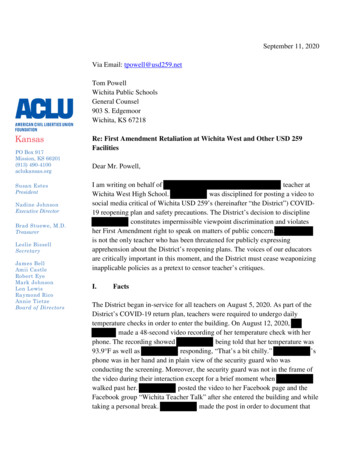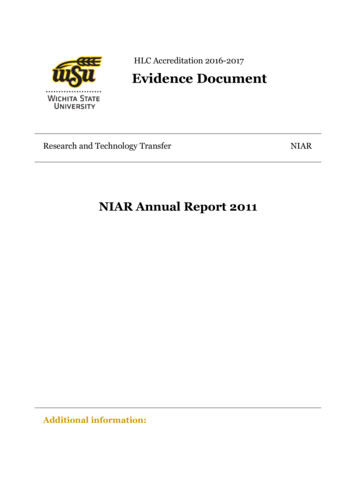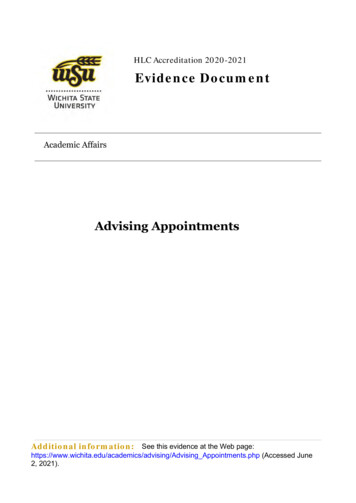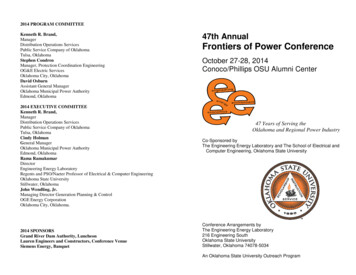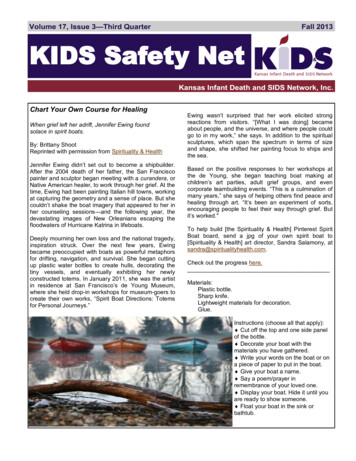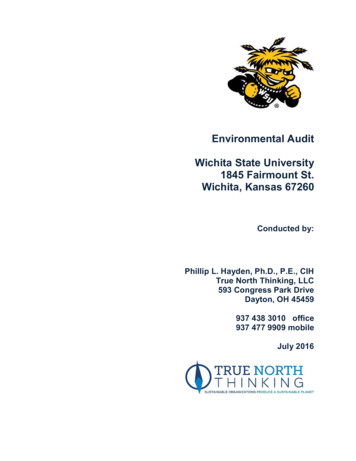
Transcription
Environmental AuditWichita State University1845 Fairmount St.Wichita, Kansas 67260Conducted by:Phillip L. Hayden, Ph.D., P.E., CIHTrue North Thinking, LLC593 Congress Park DriveDayton, OH 45459937 438 3010 office937 477 9909 mobileJuly 2016
TABLE OF CONTENTS1.0INTRODUCTION12.0REGION 7, US EPA DRAFT CONSENT AGREEMENT13.0WICHITA STATE UNIVERSITY24.0PRELIMINARY REVIEW25.0HAZARDOUS WASTE AUDIT36.0RESULTS OF HAZARDOUS WASTE AUDIT4Attachment A – Protocol for Conducting AuditsAttachment B – RESUME728
1.0INTRODUCTIONThe U.S. Environmental Protection Agency (EPA) Region 7 office in Kansas City and theKansas Department of Health and Environment (KDHE) performed a Resource Conservationand Recovery Act (RCRA) Audit of hazardous waste practices at Wichita State University(WSU) during June 2014. The University recently received a “Draft Consent Agreement andFinal Order”, US EPA Region 7, Lenexa, Kansas, regarding the results of the Audit, whichincluded violations.To mitigate potential fines, the U.S. EPA has a policy, stated in a Memorandum entitled, “Issueof the 2015 Update to the 1998 U.S. Environmental Protection Agency SupplementalEnvironmental Projects Policy”, March 10, 2015. “A Supplemental Environmental Projects (SEP)is an environmentally beneficial project or activity that is not required by law, but that adefendant agrees to undertake as part of the settlement of an enforcement action.” There areseven projects, which are suitable to the U.S. EPA, which include:· Public Health;· Pollution Prevention;· Pollution Reduction;· Environmental Restoration and Protection;· Assessments and Audits;· Environmental Compliance Promotion; and· Emergency Planning and Preparedness.WSU contracted with Philip L. Hayden, Ph.D., P.E., CIH, of True North Thinking, LLC, Dayton,Ohio, to perform an environmental audit to identify environmental issues of noncompliance andto suggest various SEPs that would comply with the EPA’s definitions of suitable projects. Ashort resume is included in Attachment B.2.0REGION 7, US EPA “Draft Consent Agreement and Final Order”.The Consent Agreement listed 13 categories which the agency alleged that WSU did notcomply with RCRA regulations. These categories were.12345678910111213Failure to conduct a Hazardous Waste Determination;Failure to Meet Generator RequirementsFailure to label Satellite Accumulation Containers with the words, “Hazardous Waste”Failure to label Containers of Hazardous Waste with the words, “Hazardous Waste”Failure to keep Waste Containers closedFailure to comply with Tank System RequirementsTreatment of Hazardous Waste without a PermitDisposal of Hazardous Waste Without a PermitFailure to Comply with the Manifest SystemFailure to Properly Manifest Off-site Shipments of Hazardous Waste OilFailure to Comply with Land Disposal Restriction RequirementsFailure to Label Used Oil ContainersFailure to Clean Up Used Oil ResiduesThese 13 categories can basically be lumped into five basic areas:·····Failure to complete appropriate paperwork;Failure to label containers properly;Failure to keep containers closed;Treating and Disposing of Hazardous Waste (wipes containing solvent); andFailure to clean-up a small oil spill and stain.Page 1 of 28
Wichita State UniversityHazardous Waste AuditJuly 11, 2016Disposal of solvent wipes - It should be noted that the KDHE Technical Guidance DocumentHW-1995-G2, “Solvent-Contaminated Wipes” was revised 05/14/2015, and reflected the U.S.EPA revised “RCRA Hazardous Waste Management System: Identification and Listing ofHazardous Waste: Conditional Exclusion From Hazardous Waste and Solid Waste for SolventContaminated Industrial Wipes” October 2013. It is not known whether the Kansas legislatureadopted this EPA regulation. The question is whether the solvent wipes are a hazardous wastewhich should be treated as a treating and disposing issue or a non-hazardous waste containerissue, with failure to be closed and labeled.3.0WICHITA STATE UNIVERSITYWSU is a major university with 15,000 students that provides a broad range of education andresearch services. The University has a total of 85 building in the inventory, with over 50building located on the Campus. The campus facilities require buildings with a broad range ofactivities to carry out its missions of advancing knowledge in the areas of education, researchand leadership. A list of activities managed by the University Storage;Police Response;Fire Response;Publications / Printing;Medical Facilities;Utilities, including Auto Repair;Landscaping;Food Service; andDormitories.WSU has four satellite locations:····WSU South is located at 200 West Greenway in Derby, Kansas, began offering WichitaState University coursework in January 2008;WSU West is located at 3801 North Walker in Maize, Kansas. This 9 acre (3.6 ha)campus hosts 80-100 university classes each academic semester;Wichita State University's 24,000-square-foot WSU West, located at 3801 Walker Ave. inwest Wichita features 13 classrooms that range in capacity of 35-70 students, acomputer lab, general science lab, interactive distance learning classroom, lounge andadministrative support space; andWSU Old Town is a complex of facilities and services located in the popular downtownWichita entertainment district. The complex comprises office space in three buildingslocated at 121 N. Mead, and buildings at 213 N. Mead and 238 N. Mead.The Eugene M. Hughes Metropolitan Complex was acquired in 1997, the 73,313square-foot Hughes Metropolitan Complex features the 1,750-seat Roger LoweAuditorium, the 145-seat Frederick Sudermann Commons and the Richard WelsbacherExperimental Theater. The complex also has a gymnasium, an 80-seat meeting roomand several classrooms. The facility houses the Division of Continuing Education,Page 2 of 28
Wichita State UniversityHazardous Waste AuditJuly 11, 20164.0PRELIMINARY REVIEWDr. Hayden visited the Wichita State University Campus during May 4 – 12, 2016, and June 4 –16, 2016. During this time, he inspected over 30 buildings, interviewed members of the EH&SGroup, persons in charge of hazardous waste activities in Chemistry, Biology, NIAR, Art andEngineering and Legal. Evaluations were conducted of the operations on Campus and inremote facilities with regard to the following EPA laws, and include:Clean Air Act (CAA) – There are no source or fugitive air emissions discharges in any of theWSU Facilities that require an air pollution permit.Clean Water Act (CWA) – There are no wastewater discharges to the Wichita sanitary sewersthat require a pretreatment permit. Permits are obtained for storm water runoff issues for newconstruction now underway at the old golf course just east of the Campus.Resource Recovery and Recovery Act (RCRA) – There are a number of departments thatGenerate Hazardous Waste, including Chemistry, Biology, Art, Engineering, Utilities andNational Institute for Aviation Research (NIAR). WSU is a Large Quantity Generator and one ofthe NIAR operations at the Coliseum is a Small Quantity Generator. As a result of thehazardous waste activities, just about all of the Dr. Hayden’s time was devoted to auditing theseactivities.Solid Waste Disposal Act – Solid waste is collected at each of the buildings and transported to acentral location. Cans and bottles are also collected separately and recycled.Emergency Planning and Right to Know Act (EPCRA) – WSU does not store hazardouschemicals in quantities enough to trigger notifications under this act. However, a significantamount of hazardous and flammable chemicals are inventoried, especially in McKinley Hall(Chemistry). The local fire department has been notified of these chemicals and basically, inthe event of a fire, fire responders may not enter the building.Superfund (CERCLA) – To the best of everyone’s memory, WSU has not illegally disposed ofregulated waste or sent hazardous waste to a TSDF that was implicated in a Superfund.However, a recommendation to the EH&S Group was that all transporters and TSDFs must beaudited to ensure a clean and compliant operation plus they have all of the proper insurances.Due to “Cradle to Grave” regulations, WSU would become liable of their TSDF would end up ina Superfund.Storm Water – WSU has initiated a number of construction projects in recent years and hascomplied with and obtained permits for all projects with regard to erosion control and stormwater runoff.5.0HAZARDOUS WASTE AUDITThe EPA document, “Protocol for Conducting Environmental Compliance Audits for HazardousWaste Generators under RCRA”, EPA 305-B-01-003, June 2001, was used as a template forconducting the Hazardous Waste Audit. The completed document is included in Attachment A.This document includes protocols that cover all the RCRA regulations that apply to a Generator.The protocols in the original document include a section referencing the specific 40 CFR 261268 regulations. A review of updated RCRA laws and regulations indicated there had been few,if any major changes since 2001.Page 3 of 28
Wichita State UniversityHazardous Waste AuditJuly 11, 2016The protocols are numbered from HW.1.1 to HW.500.1 and cover such topics as Small QuantityGenerators (SQGs), Large Quantity Generators (LQGs), Satellite Areas, Containers, andLabeling.For each protocol, there is a short or very long explanation of the meaning of the regulationcited. All of the completed protocols are included in Attachment A. An Example of the template,with protocols HW.40.1 and HW.40.2, is shown in Table 1.0. This list of protocols was importedinto WORD and the Auditor’s comments were included in the box under Reviewer. To trulyunderstand the protocols, the reader should download and print EPA 305-B-01-003, whichincludes the detailed explanations of the regulations cited in the box - “Reviewer Checks”, andmay require up to 4 pages to cover all of the nuances of a particular protocol.Table 1.0 – Example of Hazardous Waste Audit ChecklistRegulatoryRequirement orManagementPracticeReviewer ChecksSMALL QUANTITYGENERATORS (SQGs)HW.40Personnel Training6.0HW.40.1. SQG personnel arerequired to be thoroughlyfamiliar with proper wastehandling and emergencyprocedures (40 CFR262.34(d)(5)(iii)).Verify that personnel are thoroughly familiar with waste handling andemergency procedures relevant to their responsibilities during normal facilityoperation and emergencies.HW.40.2. Training recordsshould be maintained for allSQG staff who managehazardous waste (MP).Verify that training records include the following:-job title and description for each employee by namewritten description of how much training each position will obtaindocumentation of training received by name.Determine if training records are retained for three years afteremployment at the facility.RESULTS OF HAZARDOUS WASTE AUDITThe results of the Hazardous Waste audit indicated the following:6.1Environmental, Health & Safety Group (EH&S) – The two person, EH&S Group isresponsible for managing the hazardous waste program at WSU. The Manager of thisgroup has a Ph.D. in microbiology and is knowledgeable with chemical properties ofmaterials. He and his assistant have certifications as Certified Hazardous MaterialManagers (CHMM) and have received training in hazardous waste management.During the time that this audit was being conducted, the group was moving their officefrom one building to another. As a result, many of their records were packed in boxesand unavailable. Their responsibilities include:··Managing the hazardous waste management program at WSU;Training of department hazardous waste coordinators;Page 4 of 28
Wichita State UniversityHazardous Waste AuditJuly 11, 2016·····Furnishing new containers marked as “Hazardous Waste” to the Departments;Pick up the hazardous waste from the departments and transport to the StorageArea;Prepare manifests;Prepare containers for transport with accredited transporter to an TSDF; andPrepare biannual reports.The EH&S Group has no mandate from senior management, no job description andkeeps getting transferred from department to department. In addition, their relationshipwith the various departments on campus is not clearly defined.The primary responsibilities of the EHS Group should be the overall management of theEHS program, ensure that all personnel are trained and serve as in-house consultants.The group should have a clear mandate from the top management to audit all Universitydepartments and research organizations.Recommendation:1. There must be a clear directive from senior management that all departments mustcomply with environmental, health and safety regulations of the University. Authorityand Accountability must be clearly defined in each department.6.2McKinley Hall (Chemistry Department) – The responsible person in charge of thehazardous waste management program at McKinley Hall is the Stockroom Manager.Her responsibilities include:·····Managing the hazardous waste program (satellite storage) in the ChemistryDepartment;Supervising the stockroom;Managing chemical, equipment and supplies inventory;Preparing stock chemical solutions for the undergraduate laboratories; andTraining laboratory assistants in the undergraduate laboratories.Recommendations:2. The Stockroom Manager has no responsibility for or authority over the graduatelaboratories, which represent significant opportunities for improvement. Theoperations of these laboratories are under the supervision of the professorssupervising the research, which do not have and could benefit from laboratoryhazardous waste training.3. The Stockroom Manager also has no responsibilities over research laboratories thatbecome abandoned leaving large quantities of chemicals, some unmarked.4. Same as #1. There must be a clear directive from senior management that alldepartments must comply with environmental, health and safety regulations of theUniversity. Authority and Accountability must be clearly defined in each department.6.3National Institute of Aviation Research (NIAR) – NIAR consists of four separatelocations that perform different testing and research protocols. All locations appear to bein compliance with hazardous waste laws and regulations regarding satellite storageareas and status of containers.Recommendations:5. NIAR should be assigned responsibility for the environmental, health and safetyprogram for their areas of responsibility. However, NIAR will function as part of theWSU Hazardous Waste Large Quantity Generator ID Number.Page 5 of 28
Wichita State UniversityHazardous Waste AuditJuly 11, 20166.46.5Biological Sciences (Hubbard Hall) – The Biological Sciences Department generatessmall amounts of hazardous wastes and appears to handle it properly.Art Department (McKnight Art Center) – The Art Department occasionally generatessmall amounts of hazardous waste.6.6Utilities and Auto Repair – This department generates used oil, used antifreeze,solvent wipes and solvents used to clean brakes.6.7Hazardous Waste Storage Area – The hazardous waste storage area is in compliancewith the regulations. The only comment is that containers not being used should bedisposed of and the inside of the storage buildings should be organized. HazardousWaste containers should be clearly labels and visible from at least 20 ft.6.8Hazardous Waste Management in Laboratories - The US EPA adopted 40 CFR 262,Subpart K—Alternative Requirements for Hazardous Waste Determination andAccumulation of Unwanted Material for Laboratories Owned by Eligible AcademicEntities, SOURCE: 73 FR 72954, Dec. 1, 2008. Subpart K was adopted specifically forUniversity laboratories after a number of years of researching and addressing thespecial needs of these institutions. Although the US EPA adopted this regulation in2008, Kansas (KDHE) still has not incorporated Subpart K into their regulations. TheEPA states that subpart is optional. However, a normal interpretation would be that it isoptional for Universities not state agencies.An evaluation of Subpart K with regard to the needs of WSU indicates that it makessense and should be incorporated into the management of hazardous waste operationsof the various laboratories, regardless of whether KDHE agrees or not.Recommendation:6. Subpart K should be incorporated into the operations of the WSU Laboratories.6.9Training - Training must be increased with attendance mandatory for all student, facultyand staff that work with chemicals.· There are a significant number of foreign students attending WSU, includingthose with advanced degrees, who have no concept of American environmental,health and safety laws and procedures;· Some faculty supervising graduate research, also do not have much, if anytraining and experience with environmental, health and safety procedures;· Undergraduate students populate the laboratories of Chemistry and Biology.Some only take one course. The graduate assistants, who supervise theseundergraduate must be trained and in turn, train the students.· The Utilities Department, especially the auto shop requires periodic training andconstant oversight from supervisors.· The responsibilities of each Department in WSU must be clearly defined withregarding to environmental, health and safety rules of the University.Page 6 of 28
Wichita State UniversityHazardous Waste AuditJuly 11, 2016ATTACHMENT AProtocol for Conducting Environmental Compliance Audits forHazardous Waste Generators under RCRAEPA 305-B-01-003, June 2001Page 7 of 28
Wichita State UniversityHazardous Waste AuditJuly 11, 2016RegulatoryRequirement orManagement PracticeReviewer ChecksAll FacilitiesHW.1HW.1.1 The current status of anyongoing or unresolved ConsentOrders, Compliance Agreements,Notices of Violation (NOV), orequivalent state enforcementactions pertaining to RCRA orcorresponding state regulationsshould be examined.The U.S. EPA issues a CONSENT AGREEMENT AND FINAL ORDER (unsigned andnot dated) to Wichita State University and both have agreed to a settlement of thisaction before the filing of a complaint. The complaint results from a complianceinspection evaluation on June 3-5, 2014. There were eleven categories of violations;·Failure to Conduct a Hazardous Waste Determination;·Failure to Meet Generator Requirements;·Failure to Label Satellite Accumulation Containers;·Failure to label Containers of Hazardous Waste;·Failure to Keep Hazardous Waste Containers Closed;·Failure to Comply with Tank System Requirements;·Treatment of Hazardous Waste Without a Permit;·Disposal of Hazardous Waste Without a Permit;·Failure to Comply with the Manifest System;·Failure to Properly Manifest Off-Site Shipments; and·Failure to Comply with Land Disposal Restrictions.The Auditor reviewed this Consent Agreement and photos with the Environmental,Health & Safety Department to understand the background of the complaint.HW. 1.2 Facilities are required tocomply with state and localregulations concerning hazardouswaste managements.The State of Kansas is an authorized state to administer federal RCRA rules andregulations. There appear are no major state regulations that modify federalregulation. There are areas of difference of emphasis and interpretation.A major modification to 40 CRF 262 is Subpart K, which provides standards formanaging hazardous waste in academic laboratories at eligible academic entities asan alternative to the satellite accumulation area generator regulations. AlthoughSubpart K provides a number benefits for University Laboratories, such as extendedstatus of unwanted wastes, accumulation times, and disposal of legacy chemicals, theState of Kansas has failed to adopt this regulation.HW.1.3. Facilities are required tocomply with all applicable federalregulatory requirements notidentified in this checklistA walk-through audit of a major number of buildings on the Wichita State Campusindicated the only compliance issues were related to Hazardous Waste. There wereno issues related to CAA, CWA, EPCRA or CERCLA. The hazardous waste wascreated in the numerous laboratories on campusHW.1.4. Specific persons shouldbe designated responsible forhazardous waste storage areas,and the precise nature of theirresponsibilities should be specified(MP).The Hazardous Waste Management Plan has a designated person responsible for thehazardous waste storage area. Fred Plummer, CHMM, a member of the ES&T Grouphas been designated at the Responsible Person.HW.10.1. Facilities that generatesolid wastes must determine if thewastes are hazardous wastes (40CFR 262.11, 261.3, 261.4(b), and261.21 through 261.24) [RevisedJanuary 2001The hazardous waste generating departments and the EHS Group determinehazardous wastes using the following:·Knowledge of constituents of the wastes (SDSs) and whether it is listed in 40CFR 261;·Laboratory analysis; and·Process knowledge.Page 8 of 28
Wichita State UniversityHazardous Waste AuditJuly 11, 2016RegulatoryRequirement orManagement PracticeHW.10.2. Facilities which claimthat a particular material is not asolid waste or is conditionallyexempt from regulation as ahazardous waste should beprepared to provide specificdocumentation in the event of anenforcement action (40 CFR261.2(f)).Reviewer ChecksWichita State University does not have any materials that are not a solidwaste and conditionally exempt from regulation.HW.10.3. Areas where containersof hazardous waste are storedshould have secondarycontainment (MP).Satellite and Storage areas for HazardousWaste have secondary containments, anexample is the storage area in McKinley Hall,the chemistry building.HW.10.4. Generators must notoffer their waste to transporters orTSDFs that have not received anEPA identification number (4062.12(c)).Tradebe Transportation, LLC, is the transporter for WSU HazardousWaste. #INR000123497The TSD is Tradebe Treatment and Recycling, LLC, #IND000772186Page 9 of 28
Wichita State UniversityHazardous Waste AuditJuly 11, 2016RegulatoryRequirement orManagement PracticeReviewer ChecksSMALL QUANTITYGENERATORS (SQGs)HW.30GeneralHW.30.1. SQGs that generate,transport, or handle hazardouswastes must obtain an EPAidentification number (40 CFR262.12(a) and 262.12(b); 40 CFR265.11The National Institute for Aviation Research (NIAR), a research arm of WSUoperations a facility called Aircraft Structural Test & Evaluation Center(ASTEC) in the old Kansas Coliseum, Park City, Kansas, just north ofWichita.·Aging Aircraft·Ballistic and Impact Dynamics Research Lab·Composites & Advanced Materials·Full-Scale Structural TestASTEC EPA ID # KSR39275645HW.30.2. Generators of more than100 kg (220.46 lb.) but less than1,000 kg (2,204.62 lb.) of hazardouswaste per month may qualify as anSQG which can accumulatehazardous waste on-site for 180days (or 270 days) without a permitif specific conditions are met (40CFR 262.34(d)(1), 262.34(d)(4),262.34(e) and 262.34(f)).ASTEC is a SQG but currently only generates approximately 100 kg/year.However, as this department of NIAR grows and takes on larger projects fromthe U.S. government, it is anticipated that it will achieve SQG status.HW.30.3. An SQG must not offerits hazardous waste totransporters or to TSDFs thathave not received an EPAidentification number (40 CFR262.12(cTradebe Transportation, LLC, is the transporter for WSU Hazardous Waste.#INR000123497HW.30.4. SQGs of hazardouswaste are required to use manifestsand keep records of hazardouswaste activity (40 CFR 262.20,262.42(b) and 262.44).Signed copies of returned manifests are kept for three years from the date thewaste was accepted by the initial transporter.HW.30.5. SQGs are required tokeep records of waste analyses,tests, and waste determinations (40CFR 262.40(c)).Hazardous Waste records are archived for 3 years.The TSD is Tradebe Treatment and Recycling, LLC, #IND000772186No exception reports were submitted to the regulatory agency because allsigned manifest copies were received in 60 days.Page 10 of 28
Wichita State UniversityHazardous Waste AuditJuly 11, 2016RegulatoryRequirement orManagement PracticeReviewer ChecksSMALL QUANTITYGENERATORS (SQGs)HW.30GeneralHW.30.1. SQGs that generate,transport, or handle hazardouswastes must obtain an EPAidentification number (40 CFR262.12(a) and 262.12(b); 40 CFR265.11The National Institute for Aviation Research (NIAR), a research arm of WSUoperations a facility called Aircraft Structural Test & Evaluation Center(ASTEC) in the old Kansas Coliseum, Park City, Kansas, just north ofWichita.·Aging Aircraft·Ballistic and Impact Dynamics Research Lab·Composites & Advanced Materials·Full-Scale Structural TestASTEC EPA ID # KSR39275645HW.30.2. Generators of more than100 kg (220.46 lb.) but less than1,000 kg (2,204.62 lb.) of hazardouswaste per month may qualify as anSQG which can accumulatehazardous waste on-site for 180days (or 270 days) without a permitif specific conditions are met (40CFR 262.34(d)(1), 262.34(d)(4),262.34(e) and 262.34(f)).ASTEC is a SQG but currently only generates approximately 100 kg/year.However, as this department of NIAR grows and takes on larger projects fromthe U.S. government, it is anticipated that it will achieve SQG status.HW.30.3. An SQG must not offerits hazardous waste totransporters or to TSDFs thathave not received an EPAidentification number (40 CFR262.12(cTradebe Transportation, LLC, is the transporter for WSU Hazardous Waste.#INR000123497HW.30.4. SQGs of hazardouswaste are required to use manifestsand keep records of hazardouswaste activity (40 CFR 262.20,262.42(b) and 262.44).Signed copies of returned manifests are kept for three years from the date thewaste was accepted by the initial transporter.HW.30.5. SQGs are required tokeep records of waste analyses,tests, and waste determinations (40CFR 262.40(c)).ASTEC hazardous waste records are archived for 3 years. Thephoto shows the cabinet storing all of the records, plans andprocedures.The TSD is Tradebe Treatment and Recycling, LLC, #IND000772186No exception reports were submitted to the regulatory agency because allsigned manifest copies were received in 60 days.Page 11 of 28
Wichita State UniversityHazardous Waste AuditJuly 11, 2016RegulatoryRequirement orManagement PracticeReviewer ChecksSMALL QUANTITYGENERATORS (SQGs)HW.40Personnel TrainingHW.40.1. SQG personnel arerequired to be thoroughly familiarwith proper waste handling andemergency procedures (40 CFR262.34(d)(5)(iii)).The person in charge of hazardous waste management is familiar withproper waste handling and emergency procedures. He is a retired militaryperson with AF training and experience.HW.40.2. Training records should bemaintained for all SQG staff whomanage hazardous waste (MP).The person in charge of hazardous waste management is familiar withproper waste handling and emergency procedures. He is a retired militaryperson with AF training and experience.SMALL QUANTITYGENERATORS (SQGs)HW.50ContainersHW.50.1. Empty containers at SQGspreviously holding hazardous wastesmust meet the regulatory definition ofempty before they are exemptedfrom hazardous waste requirements(40 CFR 261.7).All empty containers used by ASTEC meet the regulatory definition of“empty” by having less than 2.5 cm of residue remaining or less than 3percent by weight remaining in the container.HW.50.2. Containers used to storehazardous waste at SQGs must be ingood condition and not leaking (40CFR 262.34 (d)(2) and 40 CFR265.171).All containers used by ASTEC for storing hazardous waste are newcontainers and not leaking. No used containers are used for storinghazardous waste.HW.50.3 Containers used at SQGsmust be made of or lined withmaterials compatible with the wastestored in them (40 CF 262.34(d)(2)and 40 CRF 265.172)All containers used by ASTEC are compatible with the waste stored; forexample caustics and acids are not stored in metal drums.HW.50.4. Containers of hazardouswaste at SQGs must be closedduring storage and handled in a safemanner (40 CFR 262.34(d)(2) and40 CFR 265.173)All containers inspected were closed except when it was necessary to addor remove waste.The containers were in good condition and not damaged.Page 12 of 28
Wichita State UniversityHazardous Waste AuditJuly 11, 2016RegulatoryRequirement ement orManagementPracticeReviewer ChecksHW.50.5. The handling ofincompatible wastes or incompatiblewastes and materials in containers atSQGs must comply with safemanagement practices (40 CFR262.34(d)(2) and 40 CFR 265.177).ASTEC does not have any incompatible solid or liquid wastes, accordingto Appendix E, Hazardous Waste Storage Incompatibility Chart.HW.50.6. Containers of hazardouswaste at SQGs should be managed inaccordance with specific managementpractices (MP).Containers are stored one container high, ASTEC does not generatehighly flammable wastes and there is only one small row of containers.SMALL QUANTITYGENERATORSHW.60Satelite AccumulationPointsHW.60.1. All SQGs may accumulateas much as 55 gal. of hazardouswaste or 1 qt. of acutely hazardouswaste in containers at or near anypoint of initial generation withoutcomplying with the requirements foron-site storage if specific standardsare met (40 CFR 262.34(c)).ASTEC only generates approximately 100 kg / 100 liters (25 gallons) ofhazardous waste and no acutely hazardous waste.The containers are marked “Hazardous Waste” and the containers arenew.Page 13 of 28
Wichita State UniversityHazardous Waste AuditJuly 11, 2016RegulatoryRequirement orManagement PracticeReviewer ChecksSMALL QUANTITYGENERATORSHW.70Container Storage AreasHW.70.1. Containers ofhazardous waste at SQGs shouldbe kept in storage areas in themanagement plan MP)Containers of HazardousWaste are identified andstored in an appropriatearea, according to MP.HW.70.2. SQG storage areasmust be designed, constructed,maintained, and operated tominimize the possibility of a fire,explosion, or any unplannedrelease of hazardous waste orconstituents which could threatenhuman health or the en
Wichita State University's 24,000-square-foot WSU West, . west Wichita features 13 classrooms that range in capacity of 35-70 students, a computer lab, general science lab, interactive distance learning classroom, lounge and administrative support space; and . 6.1 Environmental, Health & Safety Group (EH&S) - The two person, .
